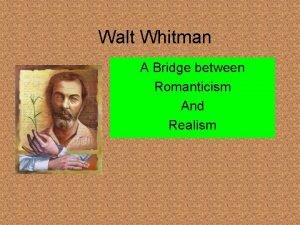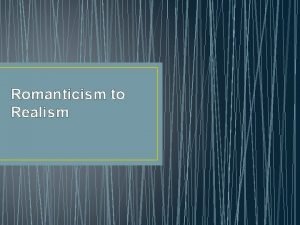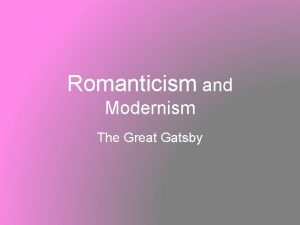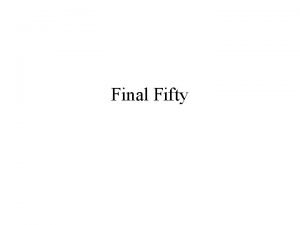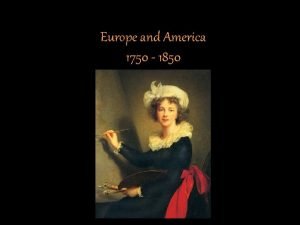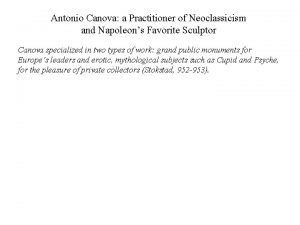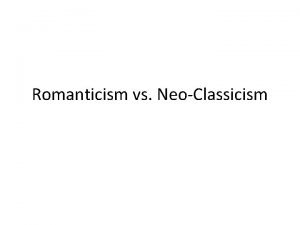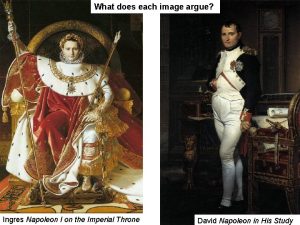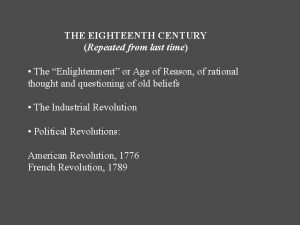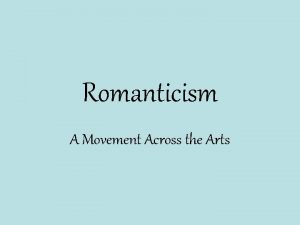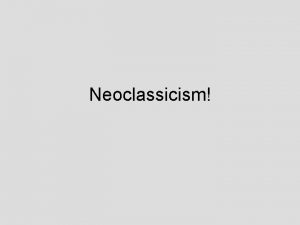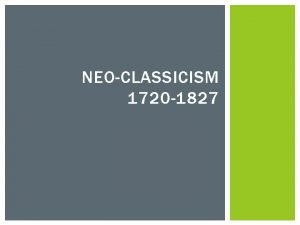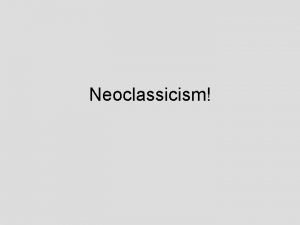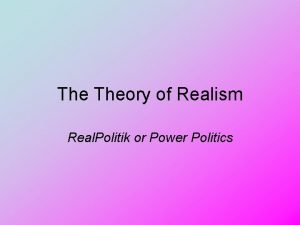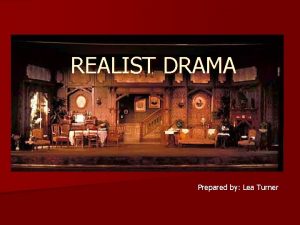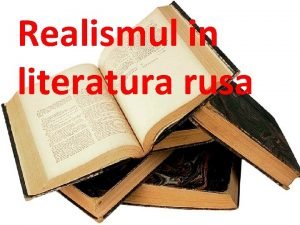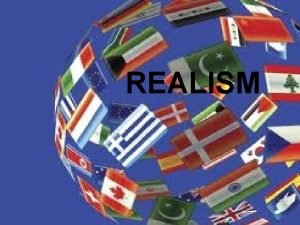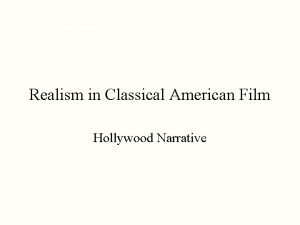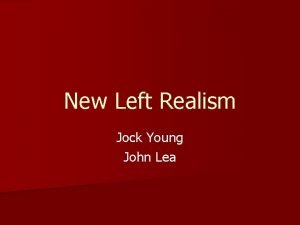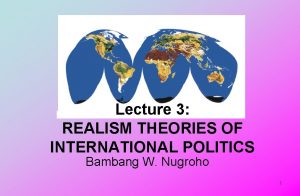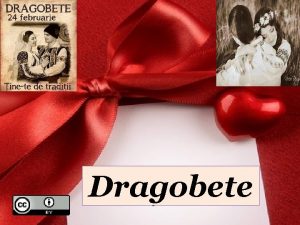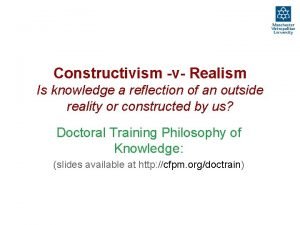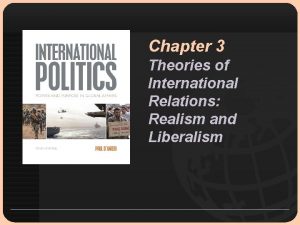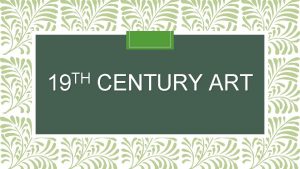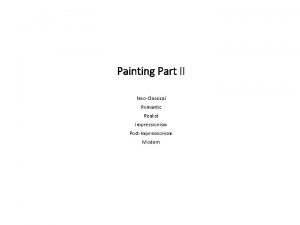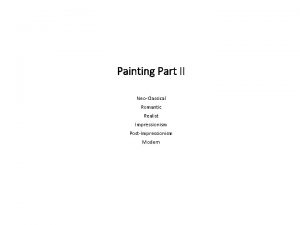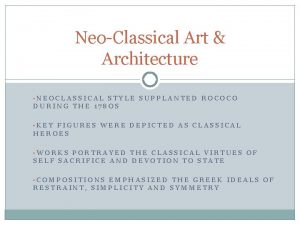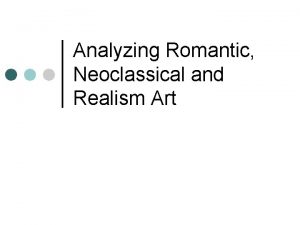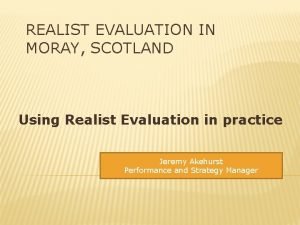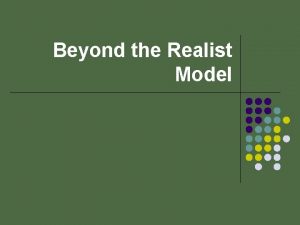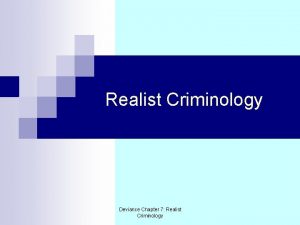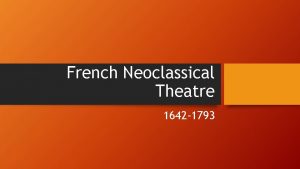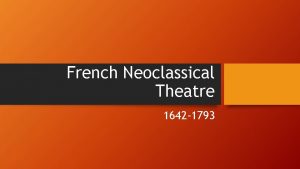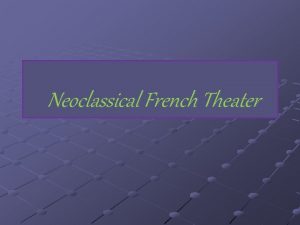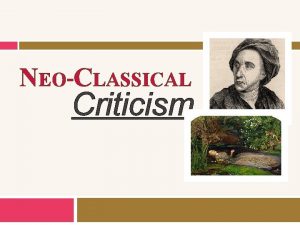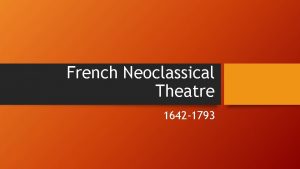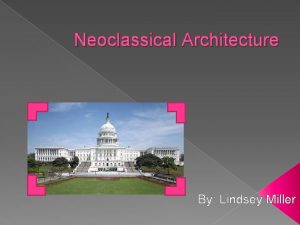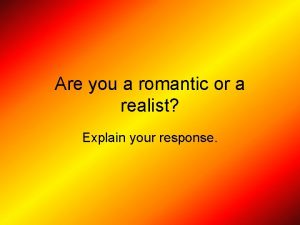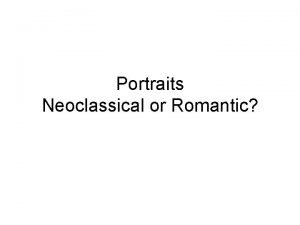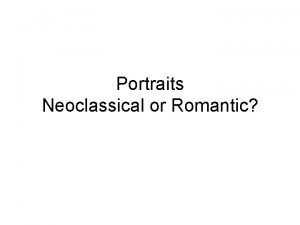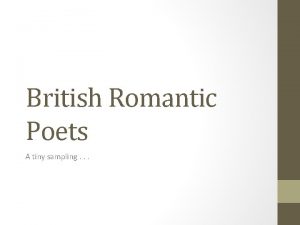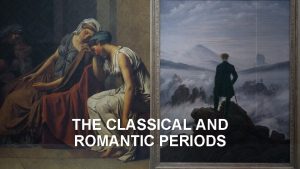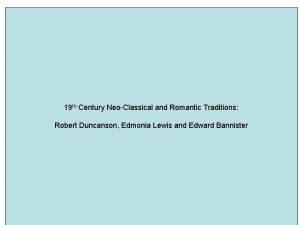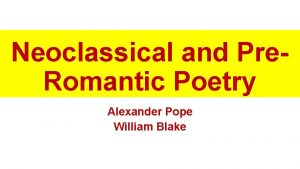Introduction to Neoclassical Romantic Realist Art Response Group


























- Slides: 26

Introduction to Neoclassical, Romantic, & Realist Art. Response Group Activity

Neoclassical Art • The Neoclassical period lasted from about 1750 -1850. Neoclassical artists revived and honored the classical art of ancient Greece and Rome. Neoclassical works of art showed a return to more traditional times, and encouraged order, reason, and discipline.

Neoclassical Painting • Based on classical Greek and Roman Art and culture • Show heroic people in scenes from or inspired by ancient history • Figures looked idealized and perfect bodies are draped in togas, or in formal elegant clothing, or are nude. • Faces are often clam, without emotion • Brush strokes tend to be smooth, barely visible.

The Lictors Bringing Brutus the Bodies of His Sons Jacques-Louis David, 1789

Neoclassical Literature and Music • Literature – Stresses the world’s harmony and order presents a logical and balanced view of human nature based on reason • Music (classical) – Mood is moderate; does not describe any extreme emotion – Melody (tune) is repeated and does not reach extreme high or low pitches (sounds)

Romantic Art • The romantic period lasted from about 1800 to the 1850’s. Romantic artists believed in the importance of returning to nature. Romantic works of art showed strong imagination and emotion, rather than the reason and intellect more common in neoclassical art.

Romantic Painting • Shows scenes of family, nature, heroism, religious and emotional subjects • Nature can be calm or stormy; there is an emphasis on the expanse of sky; people in the landscape are usually small in scale • Faces show inner thoughts and emotion, such as fear, anger, love and hope

Moonrise over the Sea Caspar David Friedrich, 1821

Romantic Literature and Music • Literature – Stresses human emotions over the rational mind – Shows wild imagination and strong emotions; common themes are heroes, childhood, the past and passionate love. • Music – Mood is emotional; a wide variety of rhythms and instruments express great sadness, joy or passion. – Melody is dramatic; volume may change suddenly ; may use very high to very low pitches.

Realist Art • The realist period lasted from about the 1830’s to 1900. Realist artists emphasized the importance of showing people and their lives as they really are. Realistic works of art depict situations from daily life, no matter how unpleasant or unheroic they might be.

Realist Painting • Based on details of daily life • Scenes of common people at work are often shown. • Figures are dressed in daily, casual, or work clothes • The human body is not idealized • Faces do not show strong emotions • Artists attempt to paint light as it really looks on and around figures and objects.

The Gleaners Jean-Francois Millet, 1857

Realist literature and Music • Literature – Describes the hardships of everyday life and criticizes the greed and bad manners of the middle class • Music (Verismo) – In opera, a play with its text set to music, mood changes with scene to imitate real-life situation of everyday characters – Melody imitates human speech and voice and conveys realistic emotions.

Analyzing Art by Historical Period • You will now work with your partners to analyzing art from the Neoclassical, Romantic and Realist periods. When your group recieves a placard carefully examine the work of art. Then, review the information in your notes to determine in which historical periodneoclassical, romantic or realist-the work was created. Circle the period on the part of the handout that corresponds with your placard. Then, write the reasons why you chose that period. Do this for each placard you receive.

Childe Harold’s Pilgrimage Joseph M. W. Turner, 1832 Romantic

The Death of Socrates Jacques-Louis David, 1787 Neoclassical

The March of the Weavers Kathe Kollwitz’s, 1897 Revolutionary, Realist

The Apotheosis of Homer Jean-Auguste-Dominique Ingres’, 1827 Neoclassical

Liberty Leading the People Eugene Delacroix, 1830 Romantic

Women Ironing Edgar Degas’. 1884 -1886 Realist

An Essay on Man Alexander Pope, 1733 Neoclassical Let Power or Knowledge, Gold or Glory, please, Or (oft more strong than all) the love of ease; Thro' life 'tis follow'd, ev'n at life's expense; The merchant's toil, the sage's indolence, The monk's humility, the hero's pride, All, all alike, find Reason on their side.

The Tables Turned William Wordsworth, 1789 Romantic • • • Up! up! my Friend, and quit your books; Or surely you'll grow double: Up! up! my Friend, and clear your looks; Why all this toil and trouble? (Stanza 1) Books! 'tis a dull and endless strife: Come, hear the woodland linnet, How sweet his music! on my life, There's more of wisdom in it. (Stanza 3) And hark! how blithe throstle sings! He, too, is no mean preacher: Come forth into the light of things, Let Nature be your teacher. (Stanza 4) She has a world of ready wealth, Our minds and hearts to bless-- Spontaneous wisdom breathed by health, Truth breathed by cheerfulness (Stanza 5) Enough of Science and of Art; Close up those barren leaves; Come forth, and bring with you a heart That watches and receives. (Stanza 8

Germinal, Emile Zola, 1885 Realist • The four colliers had spread themselves out, one above the other, to cover the whole coal-face. Each one occupied about four metres of the seam, and there were hooked planks between them to catch the coal as it fell. The seam was so thin, hardly more than fifty centimeters through at this point, that they were flattened between the roof and wall, dragging themselves along by their knee and elbows, unable to turn without grazing their shoulders. In order to get at the coal, they had to lie on one side with twisted neck, arms above their heads, and wield their short handled picks slantways. • Zacharie was at the bottom, with Levaque and Chaval above him and Maheu at the top. Each cut into the bed of shale with his pick, then made two vertical slots in the coal and finally drove an iron wedge in at the top, thus loosening a block. The coal was soft, and in its fall the block broke up and rolled pieces all over the men’s stomachs and thighs. When these pieces, stopped by the planks had collected beneath them, the men disappeared, immured in the narrow cleft.

Symphonie Fantastique Hector Berlioz, 1830 Romantic

Emperor Joseph Hayden, 1797 Classical

Cavalleria Rusticana Pietro Mascagni, 1888 Verismo Period (Realist)
 Walt whitman realism poems
Walt whitman realism poems Romanticism vs realism
Romanticism vs realism Difference between romanticism and modernism
Difference between romanticism and modernism Metaphysical poetry characteristics
Metaphysical poetry characteristics Apotheosis of homer neoclassical or romantic
Apotheosis of homer neoclassical or romantic Y no hai remedio khan academy
Y no hai remedio khan academy Canova neoclassical or romantic
Canova neoclassical or romantic David oath of the horatii
David oath of the horatii Napoleon crossing the alps era
Napoleon crossing the alps era The death of marat meaning
The death of marat meaning How is romanticism different from neoclassicism
How is romanticism different from neoclassicism Enlightenment and romanticism
Enlightenment and romanticism Characteristics of neo classical art
Characteristics of neo classical art Neoclassicism features
Neoclassicism features Neoclassical definition
Neoclassical definition Realist theory
Realist theory Core principles of realism
Core principles of realism Well made play
Well made play Left and right realism
Left and right realism Realismul rus
Realismul rus Realist theory of international relations
Realist theory of international relations Realist narrative
Realist narrative Left realist theory
Left realist theory Realist theory of international relations
Realist theory of international relations Caracterizarea lui onache carabus
Caracterizarea lui onache carabus Constructivism vs realism
Constructivism vs realism Realist theory of international relations
Realist theory of international relations
